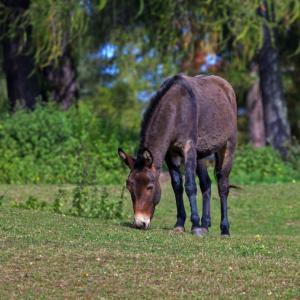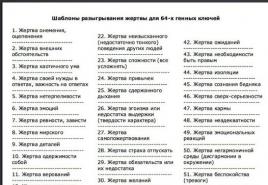Which shape is the side face of the truncated pyramid. Correct pyramid
Tasks on the topic: "Pyramid, Truncated Pyramid".
The height of a regular quadrangular pyramid is 6, and the apothem is 6.5. Find the perimeter of the base of this pyramid. Answer: 20.
The lateral surface of a regular pyramid is 24, and the base area is 12. At what angle are the lateral faces inclined to the base? Answer: 60
The volume of a regular quadrangular pyramid is 48, the height is 4. Find the area of \u200b\u200bthe side surface of the pyramid. Answer: 60.
The height of the pyramid is 16. The area of \u200b\u200bthe base is 512. At what distance from the base is the section parallel to it, if the section area is 50. Answer: 11
At the base of the pyramid lies a square with a diagonal equal to 6. One of the lateral ribs is perpendicular to the base. The larger lateral rib is inclined towards the base at 45. What is the volume of the pyramid? Answer: 36.
In a triangular pyramid, the two side faces are mutually perpendicular. The areas of these faces are equal to P and Q, and the length of their common edge is equal to a. Determine the volume of the pyramid. Answer:
The base of the pyramid is a rectangle with sides 4 and 6. Each of the side edges is 7. Find the volume of the pyramid. Answer: 48.
In the pyramid, a plane of section parallel to the base divides the height in a ratio of 1: 1. Find the cross-sectional area if the base area is 60. Answer: 15
The side edges of the triangular pyramid are mutually perpendicular, each edge is equal to 3. Find the volume of the pyramid. Answer: 4.5
The volume of a regular quadrangular pyramid is 20, and its height is 1. Find the length of the apothem of the pyramid. Answer: 4
The height of a regular triangular pyramid is half the side of the base. Find the angle between the side face of the pyramid and the plane of the base. Answer: 60
Find the volume of a regular triangular pyramid if all lateral edges are inclined to the plane of the base at an angle of 45, and the median of the base is 6. Answer: 144
The height of the base of a regular triangular pyramid is 3, the lateral edge makes an angle of 30 with the height of the pyramid. Find the volume of the pyramid. Answer: 6
Find the area of \u200b\u200bthe base of a regular triangular pyramid whose height is 10, and the dihedral angle at the side of the base is 45. Answer: 900.
All side faces of a triangular pyramid make an angle of 45 with the base plane. Find the height of the pyramid if the sides of its base are 20.21 and 29. Answer: 6
At the base of the pyramid there is a triangle with sides 7,10 and 13. Height of the pyramid 4. Find the value of the dihedral angle at the base of the pyramid if all side faces are equally inclined to the plane of the base. Answer: 60
At the base of the pyramid lies an isosceles trapezoid, the base lengths of which are 16 and 4. Find the height of the pyramid if each of its side faces makes an angle of 60 with the base. Answer: 4
The section of the pyramid by a plane parallel to the base divides the height of the pyramid in a ratio of 2: 3, counting from the top. The base area of \u200b\u200bthe pyramid is 360. Find its cross-sectional area. Answer: 57.6
The base of the pyramid is a triangle with sides 5,5 and 6, the height of the pyramid passes through the center of the circle inscribed in this triangle and is equal to 2. Find the area of \u200b\u200bthe side surface of the pyramid. Answer: 20.
The flat angles at the apex of the triangular pyramid are straight, the side edges of the pyramid are 5.6 and 7. Find the volume of the pyramid. Answer: 35
The sides of the bases of a regular truncated quadrangular pyramid are 4 and 6. Find the area of \u200b\u200bthe diagonal section if the side edge forms an angle of 45 with a large base. Answer: 10
Find the height of a regular truncated quadrangular pyramid whose base sides are 14 and 10, and the diagonal is 18. Answer: 6.
The bases of the truncated pyramid have regular triangles with sides 2 and 6. Determine the height of this pyramid if its volume is 52. Answer: 12. В
The base of the pyramid is a rhombus with side 14 and acute angle 60. Dihedral angles at the base of the pyramid at 45. Calculate the volume of the pyramid. Answer: 343.
The base area of \u200b\u200ba regular quadrangular pyramid is 36, and its side surface 60. Find the volume of the pyramid. Answer: 48
At the base of the pyramid is a triangle with sides 13, 14 and 15. Find the height of the pyramid if all the heights of the side faces are 14. Answer: 6
In what ratio does the plane parallel to the base divide the volume of the pyramid, if it divides the height in the ratio 3: 2? Answer: 27: 98
The base of the pyramid is a rhombus on side 6 and an acute angle of 30. Find the total surface area of \u200b\u200bthe pyramid if each dihedral angle at the base is 60. Answer: 54.
At the base of the triangular pyramid FABC lies a regular triangle ABC with a side equal to FA \u003d. The side faces of the pyramid have equal areas. Find the volume of the pyramid. Answer:
In the correct triangular pyramid the side edge equal to 6 is inclined to the base at an angle of 30. Find the volume of the pyramid. Answer:
The height of a regular triangular pyramid is 2, and the side face makes an angle of 60 with the base plane. Find the volume of the pyramid. Answer: 24
Find the volume of a regular tetrahedron with an edge equal to a. Answer:, a \u003d 5
The plane angle at the apex of a regular triangular pyramid is 90 *. The area of \u200b\u200bthe side surface of the pyramid is 192. Find the radius of the circle circumscribed about the side face of the pyramid. Answer: 8
The angle between the lateral face and the base plane of a regular triangular pyramid is 45. The volume of the pyramid is equal. Find the side of the base of the pyramid. Answer: 2
The base of the pyramid is a rhombus with diagonals 6 and 8, the height of the pyramid passes through the intersection of the diagonals of the rhombus and is equal to 1. Find the side surface of the pyramid. Answer: 26
IN quadrangular pyramid all lateral ribs are inclined to the plane of the base at an angle of 60. At its base lies an isosceles trapezium, the greater angle of which is 120. The diagonal of the trapezoid is the bisector of its acute angle. The height of the pyramid is 4. Find the larger base of the trapezoid. Answer: 8
Determine the volume of a regular quadrangular pyramid, knowing the angle \u003d 30, made up by its lateral edge with the base plane, and the area of \u200b\u200bits diagonal section S \u003d. Answer: 2.
The base of the pyramid is a regular triangle with a side. One of the side edges is perpendicular to the base, and the other two are inclined to the plane of the base at angles of 60. Find the area of \u200b\u200bthe larger side face of the pyramid. Answer: 3.75
The base of the pyramid is a rectangle with an area of \u200b\u200b81. Two side faces are perpendicular to the base plane, and the other two form angles 30 and 60 with it. Find the volume of the pyramid. Answer: 243
Find the volume of the pyramid, the base of which is an isosceles trapezoid with bases 10 and 20, and the lateral faces form dihedral angles equal to 60 with the base plane. Answer: 500
At the base of the pyramid lies a rectangular isosceles triangle with hypotenuse c. Each edge of the pyramid is inclined to the base plane at an angle of 45. Find the total surface area of \u200b\u200bthe pyramid. Answer:
The base side of a regular triangular pyramid is equal to a. The value of the angle formed by the height of the pyramid with the side face is 30. Find the total surface area of \u200b\u200bthe pyramid. Answer:
The angle between the height of a regular quadrangular pyramid and its side edge is 60. Find the total surface area of \u200b\u200bthe pyramid if its height is 10. Answer: 200 (3+)
The base of the pyramid is a rhombus with a larger diagonal of 12 and an acute angle of 60. All dihedral angles at the base of the pyramid are 45. Find the volume of the pyramid. Answer: 24
The bases of a regular truncated pyramid are squares with sides a and b (a\u003e b). The side ribs are inclined to the base plane at an angle a. Determine the size of the dihedral angles at the sides of the bases. Answer : arctg (tga)
In a triangular truncated pyramid, the height is 10. The sides of one base are 27.29 and 52, and the perimeter of the other base is 72. Determine the volume of the truncated pyramid. Answer: 1900
At the bases of the truncated pyramid lie right-angled triangles with an acute angle of 60. The hypotenuses of these triangles are 6 and 4. The height of this pyramid. Find the volume of the learned pyramid. Answer: 9.5.
The sides of the bases of a regular rectangular truncated pyramid are 4 and 4; the side face is inclined to the base plane at an angle of 60. Find the full surface of the pyramid. Answer: 128
The sides of the base of a regular quadrangular truncated pyramid are in the ratio 3: 2. The height of the pyramid is 3. The lateral edge makes an angle of 60 with the base plane. Find the volume of the pyramid. Answer: 114
The lateral edge of a regular rectangular truncated pyramid̊ is equal and inclined to the base plane at an angle of 60. The diagonal of the pyramid is perpendicular to the lateral edge. Find the area of \u200b\u200bthe smaller base of the pyramid. Answer: 1.5
Pyramid concept
Definition 1
Geometric figureformed by a polygon and a point not lying in the plane containing this polygon, connected to all the vertices of the polygon is called a pyramid (Fig. 1).
The polygon from which the pyramid is composed is called the base of the pyramid, the triangles obtained by connecting to the point are the side faces of the pyramid, the sides of the triangles are the sides of the pyramid, and the point common to all triangles is the top of the pyramid.
Types of pyramids
Depending on the number of angles at the base of the pyramid, it can be called triangular, quadrangular, and so on (Fig. 2).

Figure 2.
Another type of pyramid is the regular pyramid.
Let us introduce and prove the property of a regular pyramid.
Theorem 1
All lateral faces of a regular pyramid are isosceles triangles, which are equal to each other.
Evidence.
Consider a regular $ n- $ coal pyramid with top $ S $ and height $ h \u003d SO $. Let's describe a circle around the base (Fig. 4).

Figure 4.
Consider the triangle $ SOA $. By the Pythagorean theorem, we get
Obviously, this will define any lateral edge. Therefore, all side edges are equal to each other, that is, all side faces are isosceles triangles. Let us prove that they are equal to each other. Since the base is regular polygon, then the bases of all side faces are equal to each other. Consequently, all side faces are equal according to the III criterion of equality of triangles.
The theorem is proved.
We now introduce the following definition related to the concept of a regular pyramid.
Definition 3
The apothem of a regular pyramid is the height of its side face.
Obviously, by Theorem One, all apothems are equal to each other.
Theorem 2
The lateral surface area of \u200b\u200ba regular pyramid is defined as the product of the base half-perimeter and the apothem.
Evidence.
Let us denote the side of the base of the $ n- $ coal pyramid by $ a $, and the apothem by $ d $. Therefore, the area of \u200b\u200bthe side face is
Since, by Theorem 1, all lateral sides are equal, then
The theorem is proved.
Another type of pyramid is a truncated pyramid.
Definition 4
If a plane is drawn through an ordinary pyramid parallel to its base, then the figure formed between this plane and the plane of the base is called a truncated pyramid (Fig. 5).

Figure 5. Truncated pyramid
The side faces of the truncated pyramid are trapezoids.
Theorem 3
The lateral surface area of \u200b\u200ba regular truncated pyramid is defined as the product of the sum of the base semiperimeters by the apothem.
Evidence.
Let us denote the sides of the bases of the $ n- $ coal pyramid by $ a \\ and \\ b $, respectively, and the apothem by $ d $. Therefore, the area of \u200b\u200bthe side face is
Since all sides are equal, then
The theorem is proved.
Example task
Example 1
Find the lateral surface area of \u200b\u200ba truncated triangular pyramid if it is obtained from a regular pyramid with base side 4 and apothem 5 by cutting off by a plane passing through the midline of the lateral faces.
Decision.
By the middle line theorem, we get that the upper base of the truncated pyramid is $ 4 \\ cdot \\ frac (1) (2) \u003d 2 $, and the apothem is $ 5 \\ cdot \\ frac (1) (2) \u003d 2.5 $.
Then, by Theorem 3, we obtain
MUNICIPAL EDUCATIONAL INSTITUTION
"SCHOOL №2" OF THE CITY OF ALUSHTA
LESSON OUTLINE
Solving problems.
Pyramid. Truncated pyramid
Mathematic teacher
Pikhidchuk Irina Anatolyevna
2016 g.
LESSON
Geometry. Grade 11.
The lesson is 3 hours long. It is recommended to carry out with generalizing repetition.
TOPIC: Pyramid. Truncated pyramid. Solving problems.
THE MAIN TASK: Preparation for test work (identify problems; systematize and correct knowledge on the topic).
OBJECTIVES: 1) Check knowledge of the definitions: the angle between a straight line and a plane; linear angle of a dihedral angle (construction); correct pyramid.
Repeat the formulas: the volume of the pyramid; the radii of a circle inscribed and circumscribed about a polygon;
check drawing skills; the ability to justify the angles between the side edge and the plane of the base, between the side edge and the plane of the base.
reinforce computing skills.
DURING THE CLASSES:
Organizing time... Communication of the goals and objectives of the lesson.
Reiteration.
Drawings on the flap:

Assignment for drawings: formulate the definition of the angle between a straight line and a plane. Show the angle in the pictures and justify.
Main board

Show the angle between the side edge and the base plane of a regular triangular pyramid. Calculate the volume of the pyramid if the side of the base is a, the angle between the side edge and the plane of the base is a.
Find the volume of each of the given regular pyramids


CONCLUSION: 1) The angle between the side edge and the plane of the base is the angle between the side edge and the radius of the circumscribed circle about the base;
2) The angle between the lateral face and the plane of the base of the pyramid is the angle between the apothem and the radius of the circle inscribed in the base.
Homework on cards (task attached).
Geometry Grade 11, (continued)
SOLUTION OF PROBLEMS: Pyramid. Truncated pyramid.
Problem number 1. At the base of the pyramid lies right triangle... Two faces containing legs are perpendicular to the plane of the base. Show the angles between the side ribs and the base plane. Will they be equal if the triangle is isosceles.

Problem number 2. At the base of the pyramid is an isosceles triangle. The side ribs are inclined to the plane of the base at one angle. Plot the height of the pyramid and the angles between the side edges and the base plane (justify the construction)


Problem number 4. At the base of the pyramid lies a right-angled triangle. Each lateral rib forms the same angle with the base. Draw and justify the construction. Find the volume if the height of the pyramid is 7 cm and the angle between the side edge and the plane of the base is 60 0 .
CONCLUSION: The height of the pyramid is projected to the center of the circumscribed circle if: the side edges are equal; lateral ribs are inclined to the plane of the base at one angle; the pyramid is correct.
Homework. In a regular pyramid (triangular, quadrangular, hexagonal) build the angle between the side face and the base plane. Justify the construction.
and a cutting plane that is parallel to its base.
Or in other words: truncated pyramid - this is such a polyhedron, which is formed by a pyramid and its section parallel to the base.
A section parallel to the base of the pyramid divides the pyramid into 2 parts. The part of the pyramid between its base and section is truncated pyramid.
This section for the truncated pyramid turns out to be one of the bases of this pyramid.
The distance between the bases of the truncated pyramid is truncated pyramid height.
The truncated pyramid will correctwhen the pyramid from which it was derived was also correct.
The height of the trapezoid of the side face of a regular truncated pyramid is apothem the correct truncated pyramid.
Truncated pyramid properties.
1. Each side face of a regular truncated pyramid is isosceles trapezoids of the same size.
2. The bases of the truncated pyramid are similar polygons.
3. The side edges of a regular truncated pyramid are of equal size and one is inclined in relation to the base of the pyramid.
4. The side faces of the truncated pyramid are trapeziums.
5. Dihedral angles at the lateral edges of a regular truncated pyramid are of equal magnitude.
6. The ratio of the areas of the bases: S 2 / S 1 \u003d k 2.
Truncated pyramid formulas.
For an arbitrary pyramid:
The volume of the truncated pyramid is 1/3 of the product of the height h (OS) for the sum of the areas of the upper base S 1 (abcde), the lower base of the truncated pyramid S 2 (ABCDE) and the average proportional between them.
Pyramid volume:
where S 1, S 2 - the area of \u200b\u200bthe bases,
h - the height of the truncated pyramid.
Side surface area ![]() equal to the sum of the areas of the side faces of the truncated pyramid.
equal to the sum of the areas of the side faces of the truncated pyramid.
For a correct truncated pyramid:
Correct truncated pyramid - a polyhedron, which is formed by a regular pyramid and its section, which is parallel to the base.

The lateral surface area of \u200b\u200ba regular truncated pyramid is ½ of the product of the sum of the perimeters of its bases and the apothem.

where S 1, S 2 - the area of \u200b\u200bthe bases,
φ - dihedral angle at the base of the pyramid.

CH is the height of the truncated pyramid, P 1 and P 2 - perimeters of the bases, S 1 and S 2 - the areas of the bases, S side - lateral surface area, S full - total surface area:
Section of the pyramid with a plane parallel to the base.
The section of the pyramid with a plane parallel to its base (perpendicular to the height) divides the height and side edges of the pyramid into proportional segments.
The section of the pyramid by a plane that is parallel to its base (perpendicular to the height) is a polygon that is similar to the base of the pyramid, while the coefficient of similarity of these polygons corresponds to the ratio of their distances from the top of the pyramid.
The cross-sectional areas that are parallel to the base of the pyramid are related as the squares of their distances from the top of the pyramid.
S floor \u003d S main + S side.
Stage III: Virtual travel into the world of pyramids - student presentation
Stage IV - Study new topic - accompanied by a multimedia presentation
Studied concepts:
Write down the topic.
House. task: number 70.
Stage VI Reflection.
test questions
7. What is the height of the pyramid?
House task: no. 75
Grading
Appendix 1
Appendix 2
The magical properties of the pyramids
Another way to achieve the effect is to put clean spring water in the pyramid, hold it for a day, and then rub it into the scalp before going to bed. It takes longer, but more practical.
For example, if you breed fish in a glass pyramid-aquarium, the result is amazing: the water cleans itself! There are no signs of rotting, there is no slime on the bottom, the glass does not turn green and there is no need to spend money on buying aquarium filters - the pyramid cleans everything itself. The geometry of the pyramid structures the water molecules in a special way, setting a program to suppress rotting inside the aquarium.
The pyramid is a radiation damper. If you put it on a computer and correctly orient it to the cardinal points, the pyramid will create a more beneficial field. The larger the pyramid, the greater its good factor. All negative impacts will either be repaid or redistributed into something neutral.
View document content
"Truncated pyramids"
Lesson topic: Truncated pyramid, its main elements.
Lesson objectives:
Educational: to acquaint students with the concept of a truncated pyramid, its elements and formulas for calculating the areas of the lateral and full surfaces;
Developing: develop the spatial imagination of students, the ability to draw pyramids and recognize them among other spatial figures;
Educating: this topic contributes to the education of curiosity, intelligence, attentiveness and the development of interest in mathematics, the formation of accuracy in the construction of mathematical figures.
Lesson type: familiarization with new material
THAT lesson: interactive board, computer, presentations "Pyramids", "Truncated pyramids", "Virtual journey into the world of pyramids".
Lesson steps:
Stage I: organizational
Stage II Knowledge update
1) oral questioning using slides
List of questions:
(slide 2) - among the figures depicted, name the numbers of those that are pyramids.
Select the pyramids among the models.
What polyhedron is called a pyramid? Name and show their main elements, show them on models. (Slides 3.4)
Types of pyramids. (slides 5-7)
Make a drawing of a triangular and quadrangular pyramid.
What is the complete surface of the pyramid made of? (slide 8)
Properties of side edges and side faces of a regular pyramid. (Slide 9)
Formulas for calculating the areas of the surfaces of pyramids (write on the board, check on the screen) (slide 10-11)
2) solve the problem from the textbook on the finished drawings
S floor \u003d S main + S side.
Stage III: Virtual trip to the world of pyramids - presentation of students
Stage IV - Learning a new topic - accompanied by a multimedia presentation
Studied concepts:
Truncated pyramid (definition);
Truncated pyramid elements;
Correct truncated pyramid;
The lateral surface area of \u200b\u200bthe truncated pyramid;
The total surface area of \u200b\u200bthe truncated pyramid.
Write down the topic.
Draw an arbitrary pyramid each in your notebook.
Draw a plane parallel to the base.
This plane divides the pyramid into two parts. What can you say about them?
Give the definition of a truncated pyramid.
What are the main elements of the truncated pyramid?
What can you say about the side edges?
Which truncated pyramid is called correct? What can you say about its side faces?
What does the full surface of a truncated pyramid consist of?
Write a formula to calculate its total surface.
What does the side surface consist of?
Name the items that have the shape of a truncated pyramid. (slide)
Stage V Problem solving - № 71, 77 from the textbook Geometry 7-11 AV Pogorelov.
Solving problems in pairs. (Appendix 1)
House. task: number 70.
Stage VI Reflection.
test questions
1. What polyhedron is called a pyramid?
2. Which pyramid is called triangular?
3. Which pyramid is called correct?
4. What is the apothem of the correct pyramid?
5 Which pyramid is called a tetrahedron?
6. Which pyramid is called truncated?
7. What is the height of the pyramid?
8. What is the area of \u200b\u200bthe lateral surface of a regular pyramid?
9. What is the area of \u200b\u200bthe lateral surface of the truncated pyramid?
House task: no. 75
Grading
Appendix 1
Choice of problem solving - couples choose a problem and solve it.
1. The base of the pyramid is a rectangle with sides 6 cm and 8 cm. Each edge of the pyramid is 13 cm. Calculate the height of the pyramid.
2. The base of the pyramid is a right-angled triangle with legs 6 cm and 8 cm. All dihedral angles at the base of the pyramid are 60 °. Find the height of the pyramid.
3. In a quadrangular truncated pyramid, the sides of one base are 6, 7, 8, 9 cm, and the smaller side of the other base is 5 cm. Find the other sides of this base.
4. In a regular triangular pyramid with height h, a plane is drawn through the base side a, intersecting the opposite opposite lateral rib at a right angle. Find the cross-sectional area.
5. The base side of a regular hexagonal pyramid is a, and the dihedral angle at the base is 45 °. Find the volume of the pyramid.
6. In a regular truncated quadrangular pyramid, the sides of the lower and upper bases are equal to a and b, and the dihedral angle at the edge of the lower base is a. Find the volume of the pyramid.
7. Construct a section of the pyramid with a plane passing through the top of the pyramid and two given points at its base.
8. In a regular rectangular truncated pyramid, the height is 2 cm, and the sides of the bases are 3 cm and 5 cm. Find the diagonal of this pyramid.
Appendix 2
The magical properties of the pyramids
The term "pyramid" is borrowed from the Greek "pyramis" or "pyramidos". The Greeks, in turn, borrowed this word from the Egyptian language. Others believe that the term originates from the shape of the loafs in Ancient Greece ("Pyros" - rye). Due to the fact that the shape of the flame resembles the image of a pyramid, some scientists believed that the term comes from the Greek word "feast" - which means fire, and fire, as you know, is a symbol of the life of all creatures.
The pyramids can be classified as one of the most mysterious on the planet.
It has now been proven that pyramid concentrates in itself high-quality energy, useful for humans. It has been found that pyramid-shaped objects have a environment positive impact.
Czech engineer Karel Duban, a radio wave specialist, argued. that the pyramids concentrate cosmic energy, which is the "actor" in them.
He discovered a connection between the shape of the pyramid space and the biological and physicochemical processes taking place in this space.
It turned out that the energy of the pyramid shape "can do" a lot: instant coffee, standing over the pyramid, acquires the taste of natural; cheap wines significantly improve their taste; water acquires properties to promote healing, tones the body, reduces the inflammatory response after bites, burns and acts as a natural aid to improve digestion; meat, fish, eggs, vegetables, fruits are mummified, but not spoiled; milk does not sour for a long time; the cheese does not grow moldy. If you sit under the pyramid, the meditation process improves, the intensity of headaches and toothaches decreases, and the healing of wounds and ulcers is accelerated. The pyramids eliminate the geopathogenic effect around them and harmonize the interior space of the premises. The Dutch pyramid researcher Paul Likens experimented with a variety of materials: with seeds of garden crops (the radish grew 2 times larger in size than the control from the same set of seeds), herbs - they remain green and continue to carry their energy charge, the healing power increases significantly.
If you put a pyramid with certain parameters in an apartment, cockroaches leave the room.
Dressing a model of a pyramidal structure on the head of a bald person and orienting it to the cardinal points, the effect of stimulating the hair follicles is achieved. The harmonious radiation generated by the pyramid model penetrates sufficiently into the skin structure and contributes to the effect of gentle massage of the hair follicles.
Another way to achieve the effect is to put clean spring water in the pyramid, hold it for a day, and then rub it into the scalp before going to bed. It takes longer, but more practical.
The use of this method is important in conditions of increased radiation, when many children lose their hair. This is a drug-free method that does not require large financial costs and is easy to use.
According to a number of testers, ordinary water perfectly captures the energy of the pyramids and shows new properties: it acquires a pure key taste, has a healing effect, stimulates plant growth, it is also known about the effectiveness of using such water to strengthen hair, remove dandruff, soften skin and smooth wrinkles, get rid of from sweating feet, etc.
For example, if you breed fish in a glass pyramid-aquarium, the result is amazing: the water cleans itself! There are no signs of rotting, there is no slime on the bottom, the glass does not turn green and there is no need to spend money on buying aquarium filters - the pyramid cleans everything itself. The geometry of the pyramid structures the water molecules in a special way, setting a program to suppress rotting inside the aquarium.

Another example. THE FAMOUS GENETICIAN GENNADY BERDYSHEV says: "THE MEAT IN MY PYRAMID CAN EVEN LIE WITHOUT A REFRIGERATOR FOR A WHOLE WEEK!"
Having built a pyramid in his country house, the famous scientist says that in it he drops years.
The pyramid is a radiation damper. If you put it on a computer and correctly orient it to the cardinal points, the pyramid will create a more beneficial field. The larger the pyramid, the greater its good factor. All negative impacts will either be repaid or redistributed into something neutral.
And there are many such examples.
The pyramid, provided that it is oriented by the edges of the base to the cardinal points, turns into an accumulator of cosmic energy. Therefore, in last years all sorts of pyramid-shaped souvenirs are in vogue: they are believed to cleanse space, emit positive energy.












